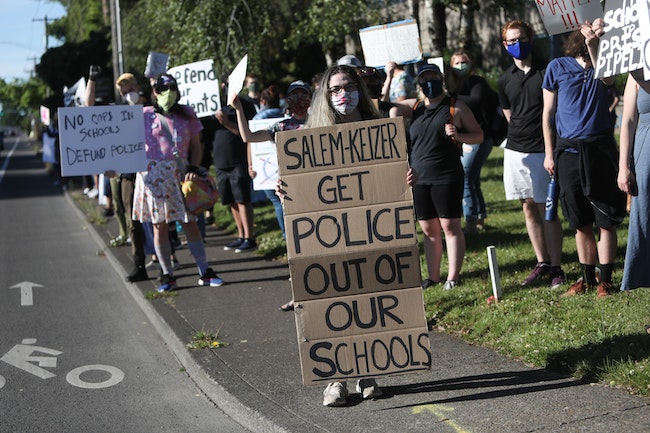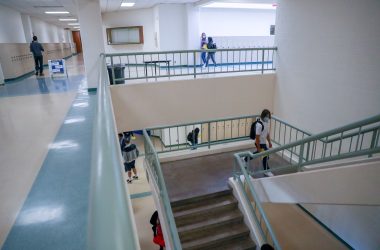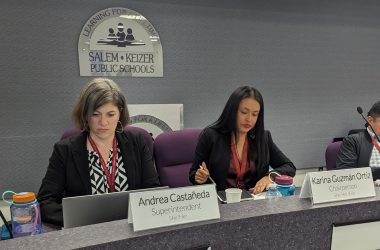 Protestors rallied outside of the Salem-Keizer school district offices on Thursday, June 18 to urge the district to cancel their contract for police officers in schools. (Amanda Loman/Salem Reporter)
Protestors rallied outside of the Salem-Keizer school district offices on Thursday, June 18 to urge the district to cancel their contract for police officers in schools. (Amanda Loman/Salem Reporter)
Salem-Keizer School District leaders plan to overhaul the district’s discipline and student safety programs, aiming to reduce racial disparities in the rates at which students are referred, suspended and expelled.
The plan is the latest effort from district administrators to respond to a call from many community groups to remove police officers from local schools, which began in June. It’s expected to take several months.
It comes after a district analysis earlier this fall found Latino, Black, Native American, Pacific Islander and multiracial students at all grade levels “receive consistently higher rates of in-school suspensions, out of school suspensions, and expulsions” than white and Asian students.
That report echoes findings from a Salem Reporter analysis in July of district discipline rates and practices.
“We’ve been really toggling back and forth with how can we have the most welcoming schools where students feel safe,” said assistant superintendent Iton Udosenata. Addressing those disparities is part of the answer, he said.
Moving ahead, he said the district wants a system based on restorative justice, where students can make amends for behavior or fix the harm they have caused, rather than simply suspending or expelling them, causing them to miss class time and become more disengaged from school.
“The punitive measures don’t necessarily contribute to character building,” Udosenata told the school board in a Dec. 8 meeting.
School police officially play no role in the district’s discipline system, though discipline at school can impact students’ juvenile court cases or probation.
But after months of meetings with a student task force, Superintendent Christy Perry said it became clear the question of police couldn’t be separated from other aspects of the district’s safety and discipline systems, which include school security officers, risk assessments for students who may be suicidal or thinking of harming others, and the child abuse investigations officers spend much of their time at schools working on.
That task force became another point of conflict after students with Latinos Unidos Siempre walked out of a meeting in late September after declining to sign a confidentiality agreement other students had requested.
Perry praised the group for its work and said students pushed for more community engagement going forward. Their recommendations, which administrators presented to the school board this week, ultimately didn’t weigh in on whether police should remain in schools. But students said if they are to stay, the district needs better accountability measures in place and officers need to prioritize mentoring, stopping young people from entering the criminal justice system and de-escalating conflicts at school.
Some of those students will be involved in the next phase of discussions, Perry said.
Perry said without more community conversations around the issue, no matter what decision the district made “we’d still have a large portion of the community that would be against it or not understand that (school resource officers) are one small piece of safety systems in schools.”
That’s been reflected in public comments to the school board. While a majority have urged removing officers from schools, many have written to say they fear a removal would leave students vulnerable in the event of a school shooting or hinder child abuse investigations.
Because school has been mostly online this year, the district does not have active contracts with the three local law enforcement agencies who typically station eleven officers in schools.
That pause gives district leaders a chance to reevaluate programs, Perry said.
“We have a chance to do this and do it right and to not make decisions that are quick and hasty,” she told the school board during a Dec. 8 meeting.
Starting in January, district leaders will begin a series of meetings with invited students and community leaders to issue recommendations. That will include representatives from many of
the groups that have called for an end to police in schools, including Latinos Unidos Siempre and the Salem-Keizer NAACP, Udosenata said, as well as the Department of Human Services and Liberty House, a child abuse assessment center.
Sandra Hernandez-Lomeli, director of Latinos Unidos Siempre, said the group agreed to participate on the condition the district engage an outside facilitator to lead the process. Perry has agreed to do so.
Hernandez-Lomeli said she’s concerned about the lack of a clear timeline to finish the work, but hopeful the discussions could address the concerns students with the group have raised for years.
“We know that the school district has a lot of work to do around the issue of discipline, but at the same time from the very beginning, we’ve been very vocal about the fact that this process is simply prolonging the actions that they should be taking around discipline. We already know the issues, we already know the problems. But we are willing to work with the school district to ensure that this is actually an equitable process,” she said.
She said Latinos Unidos Siempre’s demand to remove police from schools hasn’t changed, and said community leaders need to decide what that process will look like, not district administrators.
“We are hoping that the district actually sticks to their word,” she said.
The community group will ultimately make recommendations to Perry about what a school safety system should look like. That’s expected in the spring.
At the same time, district employees will discuss revamping school discipline to focus on restoration over punishment, Udosenata said.
Udosenata said understanding how implicit bias may play a role in discipline referrals is key to that review.
While schools occasionally have to respond to serious crimes committed on campus, he said the vast majority of discipline is students being cited for things like “insubordination,” which often means talking back in class or ignoring a teacher’s direction.
That leaves considerable leeway for a teacher to interpret one student’s outburst as a symptom of a bad mental health day, while another student may be seen as a bad kid or criminal. Those individual decisions in classrooms across the district likely contribute to the racial disparities seen in discipline rates, he said.
Contact reporter Rachel Alexander: [email protected] or 503-575-1241.
HOLIDAY SPECIAL: SAVE 25% off a one-year subscription to Salem Reporter. Get quality Salem news delivered to your inbox. Every subscription helps build coverage of the Salem community. Order online HERE.

Rachel Alexander is Salem Reporter’s managing editor. She joined Salem Reporter when it was founded in 2018 and covers city news, education, nonprofits and a little bit of everything else. She’s been a journalist in Oregon and Washington for a decade. Outside of work, she’s a skater and board member with Salem’s Cherry City Roller Derby and can often be found with her nose buried in a book.









